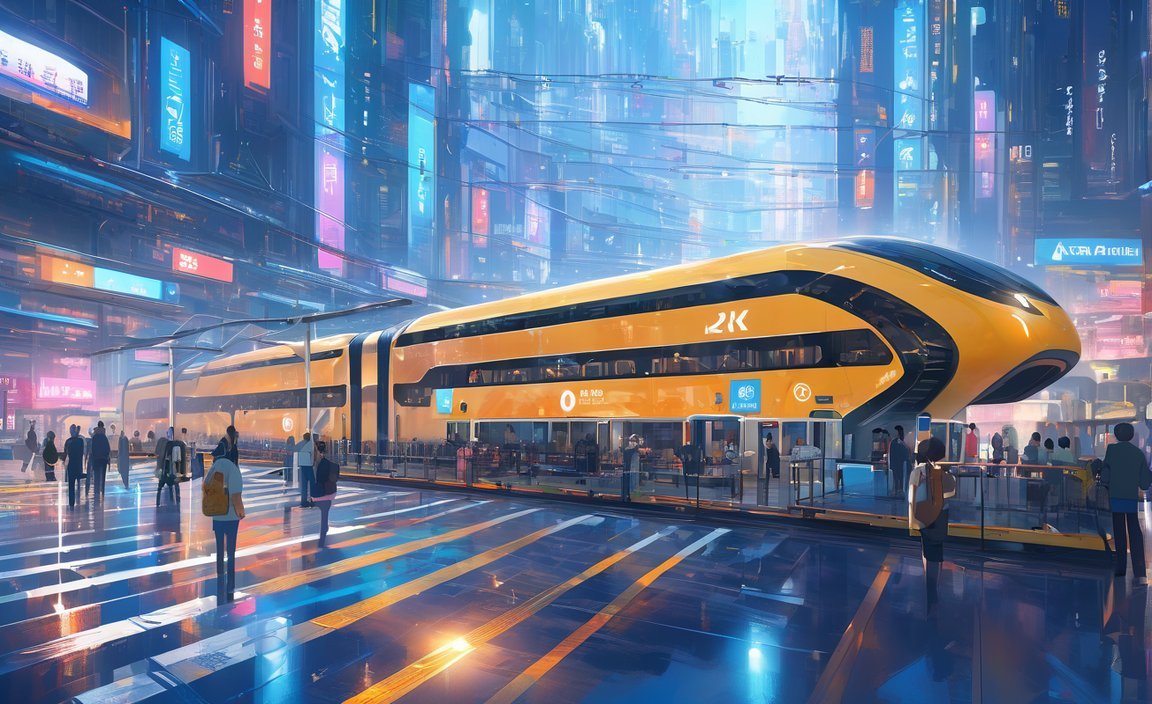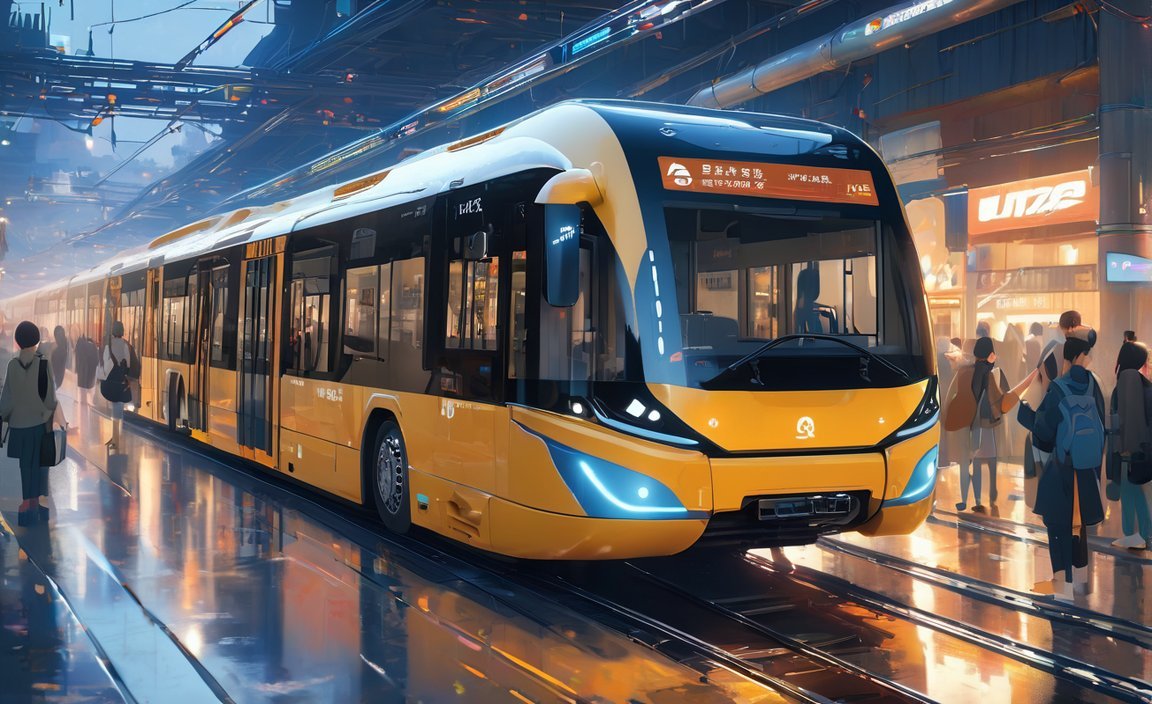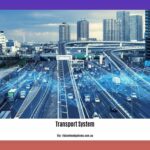Intelligent Transport Systems (ITS) have emerged as a game-changer in the transportation industry, revolutionizing the way people and goods move across the globe. With their ability to seamlessly integrate cutting-edge technologies and data-driven solutions, ITS offers a plethora of advantages that not only enhance efficiency but also promote sustainability and safety. In this article, we will delve into the numerous benefits of Intelligent Transport Systems and explore how they are reshaping the future of transportation.
Key Takeaways:
- Intelligent Transport Systems (ITS) offer advantages such as time-saving, safety, improved travel, management efficiency, and ecological benefits.
- Benefits of ITS include a reduction in stops and delays at intersections, speed control and improvement, travel time improvement, capacity management, and incident management.
- ITS processes and shares information to ease congestion, improve traffic management, minimize environmental impact, and enhance transportation benefits for commercial users and the general public.
- The technology used in ITS aims to improve the efficiency and safety of road transport, traffic management, and mobility.
- Strategic integration of ITS with information and communication technologies can optimize fleet control and management, electronic fare collection, road safety, and information delivery to users.
- Adopting ITS allows cities to utilize their current transportation resources more responsibly and increase efficiency and safety in various transportation situations.
Advantages of Intelligent Transport System

In today’s fast-paced world, transportation plays a crucial role in connecting people and goods. As the demand for efficient and sustainable transportation continues to grow, the introduction of Intelligent Transport Systems (ITS) has revolutionized the industry. These systems utilize advanced technology to improve transportation efficiency, enhance safety, and reduce environmental impact. Let’s explore the various advantages offered by intelligent transport systems.
Time-saving and Improved Efficiency
One of the key advantages of ITS is the significant time-saving it offers. By reducing the number of unwanted stops and optimizing traffic flow, intelligent transport systems help vehicles reach their destinations faster. Whether it’s intelligent traffic signal control or real-time route guidance, these technologies ensure smoother journeys with reduced delays.
Imagine driving through a city with strategically placed traffic cameras and sensors that communicate with each other to analyze traffic patterns. This information can be utilized to dynamically adjust signal timings, prioritize high-traffic routes, and avoid congestion, ultimately saving commuters valuable time.
Enhanced Safety Measures
Safety is paramount in transportation, and ITS plays a crucial role in improving this aspect. With technologies like speed control and incident management systems, intelligent transport systems contribute to accident prevention and overall road safety.
By leveraging advanced sensors and communication networks, ITS enables real-time monitoring of vehicles and road conditions. For instance, if a vehicle exceeds the speed limit, the system can automatically apply brakes or provide visual and audio alerts to the driver. Such proactive measures ensure safer journeys for everyone on the road.
Improved Travel Experience
Comfort is a significant factor when it comes to traveling. ITS focuses on enhancing the overall travel experience by incorporating various amenities and services. For example, intelligent transport systems can provide real-time information about available parking spaces, public transportation schedules, and even recommend alternative routes based on traffic conditions.
Moreover, these systems enable seamless connectivity by integrating technologies like Wi-Fi, GPS, and mobile applications. Passengers can stay connected, access real-time updates, and make informed decisions during their journey, making travel more convenient and enjoyable.
Efficient Traffic Management
Managing traffic flow efficiently is essential to avoid congestion and optimize resource utilization. With intelligent transport systems, cities can take advantage of their existing transportation resources more responsibly.
By analyzing real-time data and applying machine learning algorithms, traffic management systems can make dynamic adjustments to signal timings and lane usage. This intelligent approach minimizes bottlenecks, maximizes road capacity, and ensures smoother traffic flow for both private and public transportation.
Ecological Benefits and Sustainability
Sustainability is a pressing concern in today’s world, and intelligent transport systems contribute significantly to reducing the environmental impact of transportation. These systems help in reducing fuel consumption, emissions, and overall carbon footprint.
Through technologies like intelligent traffic signal control, optimally planned routes, and encouragement of public transportation, ITS aims to promote a shift towards greener and more eco-friendly modes of transport. By adopting intelligent transport systems, cities can pave the way for a sustainable future, balancing transportation needs with ecological preservation.
In conclusion, intelligent transport systems offer numerous advantages that revolutionize the transportation landscape. From time-saving and enhanced safety measures to improved travel experiences and efficient traffic management, the benefits are undeniable. As technology continues to advance, ITS will play a vital role in shaping a more sustainable and efficient transportation ecosystem.
[advantages of intelligent transport system]
Inland waterways offer a multitude of advantages when it comes to transportation. From cost-efficiency to environmental friendliness, exploring the perks of utilizing this mode of transport is a must. Discover the advantages of inland waterways by clicking here.
When it comes to land transportation, there are numerous advantages that make it an attractive option. From flexibility to accessibility, the benefits are aplenty. Dive deeper into the advantages of land transportation by clicking here.
Maritime transport holds a host of advantages that make it an integral part of global trade. From its ability to transport large quantities of cargo to its affordability, there are numerous reasons why it’s a preferred mode of transport. Uncover the advantages of maritime transport by clicking here.
Ocean transport offers a plethora of advantages that make it a key player in international trade. With its vast reach and ability to transport large and heavy goods, it’s a preferred choice for many industries. Learn more about the advantages of ocean transport by clicking here.
Increasing Efficiency and Cost Savings: Revolutionizing Transportation
Intelligent transport systems (ITS) have brought about a significant revolution in the transportation industry, offering numerous advantages in terms of increased efficiency and cost savings[^1^][^2^]. By implementing AI algorithms and utilizing real-time data, these systems provide logistical managers with valuable insights that optimize routes, reduce fuel usage, lower operational costs, and streamline overall operations[^1^]. Let’s dive into the key advantages of intelligent transport systems and explore how they are revolutionizing transportation.
Advantages of Intelligent Transport Systems
1. Optimized Route Planning and Resource Allocation
Intelligent transport systems utilize AI-driven algorithms to analyze data and identify the most efficient routes for transportation operations[^1^]. By considering various factors such as traffic conditions, weather, and road conditions, these systems minimize travel time, reduce fuel consumption, and ultimately lead to substantial cost savings[^1^]. Furthermore, intelligent transport systems allow for effective resource allocation, ensuring that vehicles and drivers are optimally assigned to meet the demands of each route[^1^].
2. Enhanced Safety Measures
By integrating advanced technologies and real-time data, intelligent transport systems contribute to enhanced safety on the roads[^1^]. Incident management systems, speed control technologies, and other safety features help prevent accidents and minimize risks on the transportation network[^1^]. Consequently, this not only saves lives but also reduces costs associated with accidents, such as vehicle repair and medical expenses[^1^].
3. Improved Supply Chain Efficiency
Intelligent transport systems are revolutionizing the supply chain industry by enabling autonomous transportation of goods[^1^]. By implementing self-driving vehicles and automated technologies, these systems reduce the need for long-haul drivers and optimize delivery routes, leading to improved supply chain efficiency[^1^]. This not only reduces costs but also ensures faster and more reliable delivery of goods.
4. Sustainable and Environmentally Friendly Solutions
The implementation of intelligent transport systems promotes sustainability and eco-friendly practices within the transportation sector[^1^]. By optimizing routes and resource allocation, these systems reduce fuel consumption, emissions, and the overall carbon footprint[^1^]. Through innovations such as intelligent traffic signal control and optimized routes, intelligent transport systems contribute to a greener and more sustainable future for transportation[^1^].
Key Takeaways:
- Intelligent transport systems offer numerous advantages, including optimized route planning and resource allocation, enhanced safety measures, improved supply chain efficiency, and sustainability.
- By utilizing AI algorithms and real-time data, these systems reduce operational costs, minimize travel time, and optimize fuel consumption.
- Safety features such as incident management systems and speed control technologies contribute to a safer transportation network, reducing the risks of accidents.
- Autonomous transportation of goods improves the efficiency of the supply chain by eliminating the need for long-haul drivers and optimizing delivery routes.
- Intelligent transport systems promote sustainability by reducing fuel consumption, emissions, and the overall carbon footprint of transportation.
Sources:
– Elite EXTRA: AI in Logistics: Driving Efficiency and Cost Savings
– Digi: An Introduction to Smart Transportation: Benefits and Examples
Reducing Environmental Impact
With the increasing focus on sustainability and environmental conservation, it has become imperative for the transportation industry to find ways to minimize its ecological footprint. One solution that has gained prominence in recent years is the implementation of Intelligent Transport Systems (ITS). These systems leverage advanced technologies to revolutionize transportation and offer numerous advantages in reducing the industry’s environmental impact.
How ITS Reduces Environmental Impact
Implementing ITS brings several significant environmental benefits. Firstly, by optimizing traffic flow and minimizing unwanted stops, ITS increases the capacity of the street network by 20-25%, resulting in reduced traffic congestion, lower fuel consumption, and decreased emissions. This reduction in congestion can also lead to improved air quality and a decrease in pollutant emissions by 30-50%.
Furthermore, by using technologies such as speed control and incident management systems, ITS contributes to a significant decrease in the number of accidents, which can range from 40-80%. These reduction rates not only enhance road safety but also prevent additional emissions that would have resulted from accidents.
Additionally, ITS improves travel times and decreases energy consumption by 45-70%. Real-time analysis of traffic data enables dynamic adjustments to signal timings and lane usage, ensuring efficient traffic management. By optimizing routes and providing real-time information about alternative routes, ITS helps drivers make informed choices, reducing travel times and fuel consumption.
The Economic and Social Impact of ITS
Apart from its environmental advantages, ITS also has a positive impact on the economy and society. Efficient traffic management leads to overall cost savings in road fleet management and maintenance. By reducing the need for repairs and optimizing resources, ITS decreases costs while improving infrastructure sustainability.
Moreover, ITS plays a crucial role in enhancing travel comfort and traffic conditions for drivers, collective transport users, and pedestrians. Real-time updates on parking spaces, public transportation schedules, and alternative routes allow for a smoother and more enjoyable travel experience. This increased comfort and convenience can lead to higher public trust and utilization of public transportation services.
Key Takeaways:
- The implementation of Intelligent Transport Systems (ITS) can significantly reduce environmental impact.
- ITS optimizes traffic flow, leading to a 20-25% increase in street network capacity.
- By decreasing the number of accidents, ITS contributes to a 40-80% decrease in accidents, enhancing road safety and reducing emissions.
- Travel times and energy consumption can be reduced by 45-70% through ITS.
- ITS improves travel comfort, traffic conditions, and public trust in transportation services.
- Overall cost savings can be achieved by efficiently managing road fleet and infrastructure maintenance.
Sources:
1. Małecki, K., Iwan, S., & Kijewska, K. (2014). Influence of Intelligent Transportation Systems on Reduction of Traffic Congestion and Improvement of Environmental Quality.
2. Conduent. (2020). How Intelligent Transportation Systems can reduce the environmental impact.
Enabling Smart and Connected Cities
Intelligent Transport Systems (ITS) have become a game-changer in the transportation industry, revolutionizing the way we move in smart and connected cities. By harnessing advanced technologies like the Internet of Things (IoT), computer vision, and machine learning, ITS has the power to transform our transportation systems and create safer, more efficient, and sustainable urban environments.
Safety First
One of the key advantages of ITS is its ability to enhance safety on our roads. With real-time monitoring and intelligent traffic management systems, ITS can prevent accidents and respond swiftly to emergencies. By optimizing the collection and analysis of transport-related data, advanced technologies enable proactive safety measures. The Internet of Things (IoT) allows for seamless communication between vehicles, traffic signals, and infrastructure, creating a connected ecosystem that prioritizes safety for both drivers and pedestrians.
Efficiency Amplified
Efficiency is another major benefit that ITS brings to smart cities. By leveraging real-time data analysis, ITS optimizes traffic flow, reduces congestion, and improves overall transportation operations. Unwanted stops are minimized, travel times are reduced, and fuel efficiency is increased. This not only saves time and resources but also lowers carbon emissions, contributing to a greener and more sustainable environment. ITS enables cities to make smarter decisions regarding transportation planning and resource allocation, leading to a more efficient and smooth transport network.
Driving Sustainability
In the quest for sustainable urban development, ITS plays a critical role in enabling smart and connected cities. By integrating various technologies and data-driven solutions, ITS facilitates the development of eco-friendly modes of transport. Electric vehicles and shared mobility services can be seamlessly integrated into the transportation system with the help of ITS. Furthermore, initiatives like smart parking, intelligent traffic signal control, and efficient route planning contribute to reduced environmental impact. By optimizing the use of existing resources, ITS enables cities to create a more sustainable and responsible transportation ecosystem.
Key Takeaways:
- ITS utilizes advanced technologies such as IoT, computer vision, and machine learning to enhance safety, efficiency, and sustainability in smart cities.
- Real-time monitoring and intelligent traffic management systems prevent accidents and enable swift emergency responses.
- ITS optimizes traffic flow, reduces congestion, and improves overall transportation operations, leading to reduced travel times and increased fuel efficiency.
- The integration of eco-friendly modes of transport, such as electric vehicles and shared mobility services, is facilitated by ITS.
- Smart parking, intelligent traffic signal control, and efficient route planning contribute to reduced environmental impact and a more sustainable transportation system.
Sources:
- MobiSoft Infotech. “Intelligent Transportation System for Smart Cities.” Available at: https://mobisoftinfotech.com/resources/blog/intelligent-transportation-system-for-smart-cities/
- IEEE Smart Cities. “Next Generation Networks for the World of Smart Transportation.” Available at:
FAQ

Q1: What are the advantages of Intelligent Transport Systems (ITS)?
A1: Intelligent Transport Systems offer advantages such as improved safety through real-time monitoring and intelligent traffic management systems, increased efficiency through optimized traffic flow and reduced congestion, and enhanced sustainability by facilitating eco-friendly modes of transport and reducing environmental impact.
Q2: How does ITS enhance safety in transportation?
A2: ITS enhances safety by utilizing advanced technologies like the Internet of Things (IoT), computer vision, and machine learning to optimize the collection and analysis of transport-related data. This allows for real-time monitoring and intelligent traffic management systems that help prevent accidents and respond swiftly to emergencies.
Q3: How does ITS improve transportation efficiency?
A3: ITS improves transportation efficiency by utilizing real-time data to optimize traffic flow, reduce congestion, and enhance overall transportation operations. This results in reduced travel times, increased fuel efficiency, and lower carbon emissions.
Q4: What sustainability benefits does ITS offer?
A4: ITS supports sustainability by integrating various technologies and data-driven solutions to facilitate the development of eco-friendly modes of transport, such as electric vehicles and shared mobility services. It also enables initiatives like smart parking, intelligent traffic signal control, and efficient route planning, contributing to reduced environmental impact.
Q5: How does ITS contribute to creating smarter cities?
A5: ITS plays a crucial role in creating smarter cities by enabling safer, more efficient, and sustainable transportation systems. Through advancements in technology and data-driven solutions, ITS helps optimize transportation operations, enhance safety measures, and reduce environmental impact, ultimately leading to the development of smarter cities.
Advantages of Intelligent Transport System: Revolutionizing Transportation
Advantages of Intelligent Transport System: Revolutionizing Transportation
Intelligent Transport Systems (ITS) have emerged as a game-changer in the transportation industry, with the potential to revolutionize our daily commutes and transform our cities. By harnessing the power of technology and data analysis, these systems offer a plethora of advantages that can enhance transportation efficiency, alleviate congestion, and improve overall safety. From advanced traffic management systems to real-time data insights and vehicle-to-infrastructure communication, ITS solutions are paving the way for a more seamless and sustainable future of mobility. In this article, we will delve into the various advantages that ITS brings to the table, shedding light on the immense potential it holds for shaping the transportation landscape.
Key Takeaways:
- Intelligent Transport Systems (ITS) save time by reducing unwanted stops and improving efficiency, resulting in faster travel times.
- ITS enhances road safety by controlling vehicle speeds.
- ITS provides comfort and convenience for passengers, making travel more pleasant.
- ITS enables efficient capacity management processes, optimizing the use of transportation resources.
- ITS helps reduce the impact on the environment by promoting sustainable transportation practices.
- Proper planning and implementation of ITS can save time, money, and lives while protecting public health and the environment.
- Smart transportation technology optimizes the use of current resources to create a more responsible transportation system for cities.
- ITS utilizes sensor technology, communication networks, and data analysis to collect and analyze information, improving transportation efficiency.
Advantages of Intelligent Transport System
The world of transportation is rapidly evolving, and one of the key driving forces behind this transformation is the implementation of Intelligent Transport Systems (ITS). These systems harness advanced technologies and innovative strategies to revolutionize transportation as we know it. From reducing congestion to improving safety, there are numerous advantages that ITS brings to the table.
Time-saving Efficiency
One of the most significant advantages of intelligent transport systems is the remarkable time-saving potential they offer. With ITS, unnecessary stops and delays are minimized, allowing for faster travel times and improved efficiency. Imagine a commute where you don’t have to constantly wait in traffic or struggle with congestion. ITS makes this a reality by optimizing traffic flow, helping you reach your destination in record time.
Enhanced Safety
Safety should always be a top priority when it comes to transportation, and intelligent transport systems excel in this aspect. ITS takes control of vehicle speeds, ensuring that everyone on the road travels at safe and regulated speeds. This proactive approach to safety helps prevent accidents, reduces the risk of injuries, and ultimately saves lives. With ITS, you can have peace of mind knowing that your safety is being prioritized every step of the way.
Improved Comfort and Convenience
Transportation is something that affects us all, whether we’re commuting to work or embarking on a long-distance journey. Intelligent transport systems have been designed with passenger comfort and convenience in mind. These systems provide a range of amenities and services that make traveling a more enjoyable experience. From real-time updates on arrival times to personalized route suggestions, ITS ensures that your travel is as comfortable and stress-free as possible.
Efficient Capacity Management
Managing transportation resources can be a complex task, but intelligent transport systems simplify this process by optimizing capacity usage. Through sophisticated algorithms and data analysis, ITS enables efficient capacity management, ensuring that transportation resources are utilized to their maximum potential. Whether it’s coordinating public transit schedules or dynamically adjusting traffic signal timings, ITS streamlines operations and maximizes efficiency.
Ecological Sustainability
In today’s world, promoting sustainable transportation practices is crucial for protecting the environment and reducing our carbon footprint. Intelligent transport systems play a vital role in achieving this goal. By encouraging modes of transportation that are more eco-friendly, such as carpooling or using public transit, ITS helps reduce the overall impact on the environment. This not only benefits the planet but also contributes to building healthier and greener communities.
In conclusion, the advantages of intelligent transport systems are vast and transformative. Time-saving efficiency, enhanced safety, improved passenger comfort, efficient capacity management, and ecological sustainability are just a few of the benefits these systems offer. By embracing ITS, we can revolutionize transportation and create a future where mobility is seamless, efficient, and sustainable.
Sources:
1. What is Intelligent Transport System?
2. What is Intelligent Transportation System
Inland waterways offer numerous advantages when it comes to transporting goods and people efficiently and cost-effectively. Explore the advantages of inland waterways and discover why they are a preferred mode of transportation for many industries. Visit here to learn more.
Land transportation plays a vital role in connecting people and industries across different regions. Learn about the advantages of land transportation and how it enables the seamless movement of goods and people. Click here to uncover the benefits.
Maritime transport provides a reliable and efficient means of shipping goods across the globe. Discover the numerous economic and logistical benefits of maritime transport by clicking here.
When it comes to international trade and shipping, ocean transport offers unparalleled advantages. Uncover the benefits of utilizing ocean transport in terms of cost, capacity, and global accessibility by clicking here.
Reduced Congestion and Emissions
Intelligent Transport Systems (ITS) have emerged as a game-changer in the transportation industry, offering a multitude of benefits and revolutionizing the way we navigate cities. With a strong emphasis on reducing congestion and emissions, ITS has the power to transform our transportation landscape for the better. Let’s explore how these systems can alleviate traffic woes and contribute to a greener future.
Reducing Congestion: A Breath of Fresh Air
Congestion is a persistent problem in urban areas, leading to wasted time, increased fuel consumption, and frustrating delays. However, with the implementation of intelligent transport systems, we can pave the way for a smoother and more efficient commute.
By harnessing advanced technologies, ITS provides real-time information, allowing drivers and commuters to make more informed decisions about their routes. Through features such as dynamic traffic management and predictive analytics, congestion hotspots can be identified and alternative routes suggested to alleviate the burden on heavily congested roads. This not only reduces travel times but also disperses traffic, alleviating congestion in specific areas[^1^].
Moreover, ITS enables smart traffic signal control systems that can regulate traffic flow based on real-time conditions. By optimizing signal timings and adjusting traffic patterns, ITS can minimize stop-and-go traffic, preventing unnecessary delays, and reducing fuel consumption. This not only leads to smoother traffic flow but also reduces emissions by curbing the excessive acceleration and deceleration that contribute to fuel inefficiency and pollution[^1^].
Emission Reduction: Towards a Greener Future
Transportation is a significant contributor to greenhouse gas emissions and air pollution. ITS plays a vital role in curbing these emissions, helping us transition towards a greener future.
By providing real-time data on traffic conditions and alternative routes, ITS helps reduce vehicle miles traveled. This means less time spent on the road, resulting in lower fuel consumption and reduced emissions[^2^]. Additionally, efficient traffic management and optimized signal timings enabled by ITS lead to fewer idling vehicles, which further contribute to emission reduction.
Furthermore, ITS facilitates modal shifts by integrating public transport systems seamlessly. With accurate information about transit schedules, seating availability, and real-time updates, commuters are encouraged to embrace public transportation options. This shift from individual vehicles to public transport not only reduces congestion but also significantly cuts down on emissions and energy consumption[^2^].
In the realm of commercial transport, intelligent systems promote eco-friendly practices and reduce the overall environmental impact. By providing insights into efficient delivery routes and optimized logistics, ITS helps streamline operations, minimizing unnecessary miles traveled, and reducing emissions associated with freight transport[^1^].
Key Takeaways:
- Intelligent Transport Systems (ITS) play a pivotal role in reducing congestion and emissions in the transportation sector.
- These systems provide real-time information, enabling drivers and commuters to make informed decisions, thereby dispersing traffic and alleviating congestion.
- ITS optimizes traffic signal control, minimizing stop-and-go traffic and reducing fuel consumption and emissions.
- By reducing the number of vehicles on the road and promoting modal shifts towards public transport, ITS helps decrease fuel consumption and emissions.
- ITS also aids in streamlining commercial transport, minimizing unnecessary miles traveled and reducing emissions in the freight sector.
Sources:
- Insights by Conduent: How Intelligent Transportation System Helps to Reduce Traffic Congestion
- NEC New Zealand: What are the benefits of intelligent transport systems?
Optimized Public Transportation
Intelligent Transport Systems (ITS) have revolutionized the transportation industry, offering immense advantages that optimize public transportation. Through the utilization of advanced technologies and data-driven strategies, ITS has the power to transform the way we commute and travel. Let’s explore the key benefits of optimized public transportation with ITS:
Safety: Ensuring Safe Journeys
The integration of IoT, computer vision, and machine learning technologies in ITS enhances road safety (source). These systems optimize transport-related data, continuously monitoring and analyzing the road environment. By controlling vehicle speeds and foreseeing potential accidents, ITS prioritizes safety and prevents injuries. As a result, commuters can experience peace of mind while enjoying their journeys.
Efficiency: Smoothing Traffic Flow
ITS focuses on efficient data collection, analysis, and interpretation, making the transport system more manageable and seamless. Real-time data and predictive analytics enable better traffic flow management, reducing congestion and travel time (source). With ITS, unnecessary stops and delays are minimized, allowing for a more efficient and time-saving commute. This optimized public transportation not only benefits individual travelers but also contributes to the overall productivity of a city.
Sustainability: Toward Eco-Friendly Transportation
ITS plays a crucial role in enabling sustainable transportation for smart cities. By optimizing transportation routes, minimizing fuel consumption, and reducing emissions, ITS contributes to a more eco-friendly transport system (source). With reduced emissions, optimized public transportation becomes a key player in mitigating the impact of climate change. By embracing ITS, cities can foster a greener future, improving the overall quality of the environment.
Improved Planning and Operations: Enhancing Public Transportation
ITS offers significant advantages when applied to public transportation. Automated data collection enables better planning and operations, providing valuable insights for service enhancements (source). By further developing planning and operational tools that leverage the potential of ITS, cities can optimize their public transportation systems. This leads to smoother operations, reduced wait times, and improved experiences for commuters.
Responsible Resource Utilization: Optimizing Transportation Systems
Smart transportation technology empowers cities to make more responsible use of their resources. By leveraging ITS, cities can optimize their transport systems, maximizing efficiency and capacity management through algorithms and data analysis (source). This results in reduced waste and improved resource allocation. Optimal utilization of resources not only benefits the transportation sector but also contributes to a more sustainable and efficient urban environment.
Future Trends: Advancing Mobility
The future of ITS holds exciting advancements in connectivity, automation, and data analytics. Integration of autonomous vehicles, real-time traffic management, and personalized transportation services are on the horizon (source). These advancements will revolutionize the way we commute and travel, offering greater convenience, improved safety, and enhanced efficiency. With optimized public transportation at the forefront, the future transportation landscape promises a seamless and connected mobility experience.
Key Takeaways:
- Intelligent Transport Systems (ITS) prioritize safety, optimizing transport-related data to prevent accidents and injuries.
- ITS enhances efficiency by utilizing real-time data and predictive analytics to reduce congestion and travel time.
- With a focus on sustainability, ITS contributes to eco-friendly transportation practices by optimizing routes and reducing emissions.
- Improved planning and operations in public transportation are made possible with ITS, leading to enhanced experiences for commuters.
- ITS enables responsible resource utilization, maximizing efficiency and capacity management for the transportation sector.
- The future of ITS entails advancements in connectivity, automation, and data analytics, bringing forth a connected and efficient mobility experience.
Sources:
– MobiSoft Infotech: Intelligent Transportation System – Best Option for Smart Cities
– SpringerOpen: Combining ITS and optimization in public transportation
Smart Infrastructure and Real-Time Data Analysis
The integration of smart infrastructure and real-time data analysis has revolutionized the transportation industry. With the power to optimize efficiency, reduce congestion, and enhance safety, intelligent transport systems (ITS) have become a game-changer in the way we navigate our cities. By leveraging advanced technologies and data-driven solutions, smart infrastructure and real-time data analysis work hand in hand to create a seamless and sustainable transportation ecosystem.
Advantages of Smart Infrastructure
Smart infrastructure forms the backbone of intelligent transport systems, allowing for the seamless flow of data and communication between vehicles, infrastructure, and individuals. Here are the key advantages of smart infrastructure:
Enhanced Traffic Efficiency: Smart infrastructure enables real-time monitoring of traffic conditions, allowing for proactive traffic management. By analyzing data from sensors, communication networks, and software applications, transportation authorities can make informed decisions to optimize traffic flow, reduce bottlenecks, and minimize travel times.
Improved Safety: The integration of smart infrastructure with real-time data analysis enables the early detection of potential hazards on the road. By leveraging technologies such as IoT, computer vision, and machine learning, intelligent transport systems can identify and mitigate risks, preventing accidents and ensuring safer journeys for all road users.
Effective Management of Transportation Networks: Smart infrastructure facilitates efficient management of transportation networks by providing accurate and up-to-date information. With real-time data analysis, transportation authorities can monitor the performance of infrastructure, identify areas of improvement, and make data-driven decisions to optimize capacity and plan for future transportation needs.
The Power of Real-Time Data Analysis
Real-time data analysis is a crucial component of intelligent transport systems, enabling transportation authorities to make informed decisions and improve overall system performance. Here’s why real-time data analysis is essential:
Optimized Traffic Flow: Real-time data analysis allows transportation authorities to monitor traffic conditions in real-time, enabling them to identify congested areas, analyze traffic patterns, and implement strategies to improve traffic flow. By leveraging predictive analytics, transportation authorities can anticipate traffic congestion and take proactive measures to mitigate its impact.
Improved Decision-Making: Real-time data analysis provides transportation authorities with valuable insights into the performance of transportation networks. By analyzing data on traffic volume, speed, and congestion levels, authorities can make data-driven decisions to optimize infrastructure, adjust signal timings, and allocate resources efficiently.
Enhanced Efficiency: Real-time data analysis enables transportation authorities to identify inefficiencies in the transportation system. By analyzing data on travel times, average speeds, and route choices, authorities can identify areas for improvement, such as the need for new infrastructure, the implementation of alternative transportation modes, or the optimization of existing routes.
Key Takeaways:
- Smart infrastructure and real-time data analysis are key components of intelligent transport systems (ITS).
- Smart infrastructure enhances traffic efficiency, improves safety, and enables effective management of transportation networks.
- Real-time data analysis optimizes traffic flow, improves decision-making, and enhances overall transportation system efficiency.
Sources:
- MobiSoft Infotech: Intelligent Transportation System – Best Option for Smart Cities
- SpringerOpen: Combining ITS and optimization in public transportation
FAQ
Q1: What are the advantages of Intelligent Transport System (ITS)?
A1: The advantages of Intelligent Transport System include time-saving by reducing unwanted stops and improving travel efficiency, enhanced safety through vehicle speed control, increased comfort and convenience for passengers, efficient management of transportation resources, and promoting sustainable transportation practices.
Q2: How does Intelligent Transport System (ITS) contribute to reducing traffic congestion?
A2: Intelligent Transport System (ITS) helps reduce traffic congestion by optimizing the use of transportation resources, improving traffic flow management through real-time data analysis, and minimizing stop-and-go traffic. This leads to decreased travel time and an overall reduction in congestion on the roads.
Q3: How does Intelligent Transport System contribute to sustainable transportation?
A3: Intelligent Transport System (ITS) plays a significant role in achieving sustainable transportation practices. By optimizing transportation routes, reducing fuel consumption, and minimizing pollutant emissions, ITS promotes a more eco-friendly and sustainable transport system.
Q4: What technologies are used in Intelligent Transport System (ITS)?
A4: Intelligent Transport System utilizes technologies such as sensors, communication networks, data analysis, and software applications. These technologies collect and process information about traffic conditions, vehicle movements, and transportation infrastructure to improve transportation systems and enable better decision-making.
Q5: How does Intelligent Transport System (ITS) enhance safety on the roads?
A5: Intelligent Transport System enhances safety on the roads through the use of advanced technologies such as IoT, computer vision, and machine learning. These technologies optimize transport-related data and operational processes, leading to safer road conditions and reducing the risk of accidents.
- Amazing March Fun Facts: Unveiling History & Celebrations - April 15, 2025
- Master how to write height: A complete guide - April 15, 2025
- How High Are Your Standards Test: Find Your Perfect Match Now - April 15, 2025
















